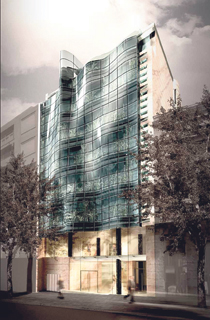Twisters like the Torso Tower in Malmö and Blobs like the Guggenheim Museum may seem pretty extravagant, but buildings can now look much more organic, thanks to a TU Delft technique to freely curve glass.
Instead of making all kinds of curves using flat glass panels that are attached to metal frames, each with a slightly different angle, like scales on a fish, architects are now experimenting with doubly curved glass panels mounted side by side. This not only makes freely bending surfaces look smooth from a distance, they actually become smooth.
“The absolute landmarks are the glass roof stations of a new cable railway line in Innsbruck, named the Nordkettenbahn”, says Daan Rietbergen, an expert in free-formed glass buildings at the faculty of Architecture (department: design of construction). When he shows pictures of these free-formed floating sculptures, it’s as if majestic melting icebergs appear on his computer screen.
Rietbergen and his colleague and supervisor, dr. Karel Vollers (department: building technology), are currently working on an apartment building project in Belgrade that must equal these glimmering masterpieces – or at least the building’s façade, which is made entirely of glass and looks like a rippling water surface, must do so. The building should be finished by the end of this year.
For this project, a Dutch company, Tetterode Glas Voorthuizen, is making the curved glass panels using a novel, recently patented technique that allows for the glass to be transformed with an adjustable mould.
Bending freely curved glass the way craftsmen do is a tricky process, to say the least, when done using traditional methods, says Vollers, who adds that only one out of six glass panels makes it through the bending process intact.
Vollers: “In order to obtain the 1,000 glass parts the Nordkettenbahn stations are made out of, the Chinese contractors who made the structures had to throw away 5,000 broken or malformed panels.”
The Chinese contractors made a mould for every single glass part, and then on top of the mould they placed a flat glass panel. In the oven, that panel, when hot, drapes across the mould like a cloth, and takes the shape of the mould. Unfortunately, most panels break, because not all the parts in the glass soften evenly, and the forces on the panel are not distributed equally either. The material, manpower and energy costs are therefore enormous, as are the costs involved in making a unique mould for every single panel.
“This isn’t a problem for the Chinese contractor”, Vollers says with a smile. “The energy they use is subsidized by the Chinese government, and their workers are extremely cheap. But if we, as Europeans, want to do the same, we have to use a different technique and rationalize.”
The adjustable mould Vollers and Rietbergen invented consists of two layers made of horizontal parallel steel rods that can cross one another, like in an egg slicer. The purpose of the top layer is to hold the plate stable when the glass is still hard. The rods that comprise the underlying layer are flexible and can all be curved differently, thus forming the actual mould.
When the glass softens (at about 570 °C), the top layer is lowered. The glass then rests on the underlying mould, draping across it, and assuming the shape of the mould.
“It’s shockingly simple”, Vollers admits, “but what can I say, nobody ever thought of it before.”
The next thing Vollers and Rietbergen will do is to make the mould computer-controlled and integrate it with the oven, which, they hope, will help take the industrialization of freely bending glass a step further again.
Will this also be a good thing for the environment?
Vollers says yes: “Our technique reduces the energy costs and waste.” Rietbergen however disagrees: “That would only be the case if architects were planning to use doubly bended glass anyway. Flat panels are still a lot better for the environment.”
“Well, I’m not so sure about that”, Vollers counters. “Buildings with extraordinary forms are less susceptible to changing trends and fashions. They tend to survive longer.”
Dr.ir. Rien Huurman van de sectie weg- en railbouwkunde (Civiele Techniek en Geowetenschappen) vindt de opwinding overdreven. Hij werd afgelopen week gebeld door televisie en kranten met de suggestie dat zoab maar vervangen moest worden door beton en dat het feit dat Noorwegen geen zoab heeft, een aanwijzing is voor de ongeschiktheid ervan voor vorst. Onzin, zegt Huurman desgevraagd. “Op een lengte van zevenduizend kilometer snelweg zijn er vorige week op de A27 en de A6 totaal enkele kilometers beschadigd geraakt. Dat is minder dan een promille.” Dat Noorwegen geen zoab gebruikt, heeft niets met vorst te maken, wel met kosten. Zoab wordt eigenlijk alleen in Japan en Nederland toegepast, vertelt Huurman, om reden van geluidsvermindering. Dat maakt dichtbevolkte gebieden een stuk beter leefbaar. Bijkomend voordeel is de grotere verkeersveiligheid, doordat regenwater snel wegstroomt en er geen splash and spray ontstaat na een regenbui. Daar staan hogere kosten tegenover, niet vanwege de aanleg, maar doordat de levensduur van zoab korter is dan van dicht asfalt. In Japan wordt daarom zoab preventief na zeven jaar vervangen. In Nederland gebeurt dat vaksgewijs naar aanleiding van inspecties.
“Wat nu gebeurt, is dat op een paar plekken de veroudering onverwacht snel is doorgezet, waardoor er gaten begonnen te vallen. Dat is het echte nieuws”, aldus Huurman.
“Je moet je zoab voorstellen als een driedimensionale ketting van steentjes van ongeveer een centimeter groot, die aan elkaar geplakte zitten met taaie teer”, vertelt Huurman. In de loop van de tijd verdwijnen er steentjes uit het vier tot vijf centimeter dikke wegoppervlak. Dat losraken is een gevolg van verkeersbelasting en weersinvloeden. Elke keer dat er een autoband overheen raast, wordt het netwerk van steentjes belast. Op den duur levert dat vermoeidheidsverschijnselen op in de plakbruggen tussen de steentjes. Daarnaast hebben weer en wind relatief meer invloed op zoab dan op een gesloten wegdek, vanwege het open karakter. Volgens Huurman tast dat de plaklaag op twee manieren aan: door veroudering en door inwerking van vocht. Tot zover de normale veroudering.
Maar hoe zijn dan opeens de gaten gevallen? Huurman wijst erop dat de gaten in verouderde wegvlakken zijn gevallen, en hij vermoedt daarom ‘een versneld overlijden’. Normaal gesproken was vervanging pas op termijn nodig geweest. Huurman denkt dat vooral de vorst/dooi-cycli noodlottig zijn geweest. Als gevolg van normale slijtage bevatte het plakmateriaal al scheurtjes. Door opvriezen zijn die herhaaldelijk opgerekt. Bovendien was het plakmateriaal door de kou extra bros. Die wisselwerking zou de plotselinge versnelling in slijtage kunnen verklaren. Zeker is dat niet. Wat dat betreft wacht Huurman op de onderzoeksresultaten van Rijkswaterstaat. Want dat er onderzoek naar komt staat voor hem wel vast: “Dit krijgt een staartje.”



Comments are closed.